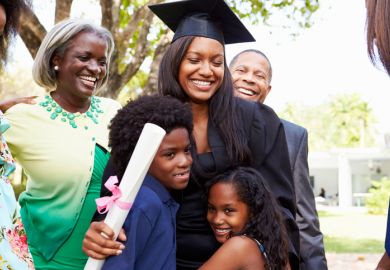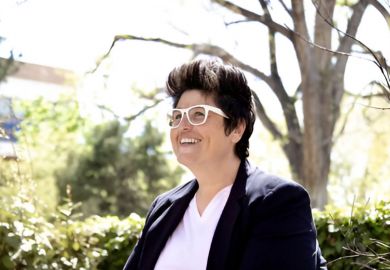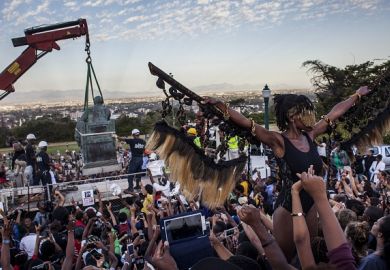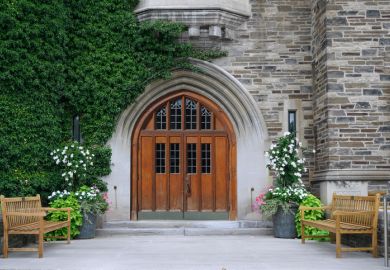The University of Virginia took to Twitter on Wednesday to clarify: the university’s newly relocated and expanded Multicultural Student Center is open to everyone at the university.
Only a few hours earlier, a video posted on Twitter by the conservative group Young America’s Foundation and others had gone viral. In the video, a young black woman stands up in what many identified as the university’s Multicultural Student Center.
“Frankly, there are just too many white people in here, and this is a space for people of colour, so just be really cognisant of the space that you’re taking up, because it does make some of us POCs [people of colour] uncomfortable when we see too many white people in here,” she says to the room. “There’s the whole university for a lot of y’all to be at, and there’s very few spaces for us, so keep that in mind.”
The university swiftly posted a statement on Twitter.
“Earlier this month the university announced the relocation and expansion of its Multicultural Student Center as part of an effort to offer a variety of spaces that embrace and support the diversity of this institution,” it read. “In order to foster the diversity of experience and ideas that make UVA a great and good place to study and work, these centres are open to all members of the university community.”
The centre had just been reopened in a new and expanded space on 6 February, along with the university’s LGBTQ centre. A dedicated Latinx Student Center and an Interfaith Student Center were opened on the same day.
In the following 24 hours, right-wing outlets ran with the story and, in the wake of increased attention, some students voiced their concerns on Twitter for the student in the video and called on the university to support and protect her. Others emphasised that she did not ask anyone to leave, only to exercise awareness. A few noted that white students did not frequent the multicultural centre where it was previously located, in a basement.
When the Multicultural Student Center was created at the University of Virginia, university officials and students stressed that it was open to all.
In 2014, students from different organisations formed the Multicultural Student Center Initiative to advocate for such a space. They researched peer institutions, assessed student needs and crafted proposals. Students from ethnic minorities comprise about one-third of the undergraduate population at UVA.
The original Multicultural Student Center opened in the basement in Newcomb Hall in autumn 2016, with couches and group tables. It housed the offices of the Multicultural Student Services staff. Programming was held in the space, which had a student director.
Shaun Harper, professor and executive director of the University of Southern California Race and Equity Center, said that when resources are available, creating several more specific centres for cultural groups can be preferable to one larger centre.
“I am a proponent of smaller, well-resourced centres that have been thoughtfully created to serve the specific needs, experiences and cultural identities of specific groups,” he said. When resources aren’t available, a larger multicultural centre is likely the best option.
“But even with a multicultural centre, institutions have to exercise high degrees of intentionality in the creating of those spaces to ensure that they don’t default to an ‘All Lives Matter’ kind of space,” Professor Harper said.
On a website for the Multicultural Student Center Initiative, since taken down, student advocates laid out their mission. The space would allow students to “meet, collaborate, and innovate”.
“We could open up an avenue for intercultural thought and dialogue to spread around the university,” the initiative said on its page in August. “This centre can become a space that is not only used by minority students but also by everyone at U.Va.”
Other students who were involved in the effort emphasised that the centre was meant to be open to anyone.
“We want people to be able to study, hang out and host meetings here, or reserve the space in the evening hours for events,” Catalina Pinto, the inaugural student director, said in a news release from the university. “Even though it’s called the Multicultural Center, it is absolutely open to anyone. We want to make sure everyone is welcome in this space.”
Professor Harper said that at the hundreds of colleges and universities he has been to and studied, he has never seen one with a specific “no whites allowed” policy.
“Oftentimes white students just presume that those spaces are not for them,” he said.
But universities might be passing over a chance to intentionally involve white students in specific ways, he said.
“Colleges and universities oftentimes miss the opportunity to say to white students that this centre can be a rich site for cultural learning. That if you, as a white student, want to learn more about the cultural histories and cultural identities and cultural assets of indigenous people, Asian American people, African American people and Latino people, that these centres can be a fruitful site for you to access that learning.”
This is an edited version of a story that first appeared on Inside Higher Ed.
Register to continue
Why register?
- Registration is free and only takes a moment
- Once registered, you can read 3 articles a month
- Sign up for our newsletter
Subscribe
Or subscribe for unlimited access to:
- Unlimited access to news, views, insights & reviews
- Digital editions
- Digital access to THE’s university and college rankings analysis
Already registered or a current subscriber?








